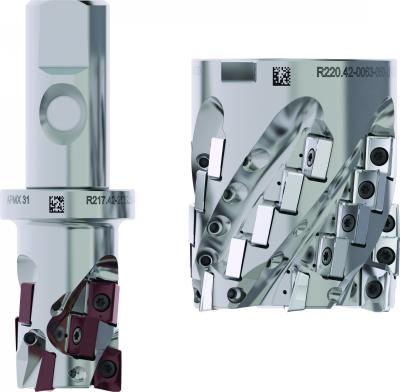
The Seco LN4-11 Helical Milling Cutter sets a new benchmark for efficiency, delivering up to three times longer tool life per edge and reducing the cost per part. Designed for applications requiring diameters between 32 and 63 mm, the cutter achieves high material removal rates, making it a versatile choice for general engineering, automotive, and aerospace sectors.
Engineered with cost-effectiveness and usability in mind, the LN4-11 features inserts that are easy to replace without risk of incorrect placement, reducing waste and downtime. Operators can switch between applications simply by changing inserts, helping shops minimize tooling inventory and associated costs. Each cutter is equipped with a unique Data Matrix code for instant access to cutting data, spare part tracking, and compatible tooling information.
The LN4-11 includes two insert types: front inserts with two cutting edges and helical inserts with four. This design ensures reliable, aggressive material removal while enhancing tool life and overall cost performance. Inserts are available in a variety of grades and geometries to handle a wide range of operations and materials.
By combining robust performance, adaptability, and advanced tracking technology, the LN4-11 provides shops with an efficient solution for increasing productivity and meeting the demands of modern manufacturing.
Contact Details
Related Glossary Terms
- gang cutting ( milling)
gang cutting ( milling)
Machining with several cutters mounted on a single arbor, generally for simultaneous cutting.
- milling
milling
Machining operation in which metal or other material is removed by applying power to a rotating cutter. In vertical milling, the cutting tool is mounted vertically on the spindle. In horizontal milling, the cutting tool is mounted horizontally, either directly on the spindle or on an arbor. Horizontal milling is further broken down into conventional milling, where the cutter rotates opposite the direction of feed, or “up” into the workpiece; and climb milling, where the cutter rotates in the direction of feed, or “down” into the workpiece. Milling operations include plane or surface milling, endmilling, facemilling, angle milling, form milling and profiling.
- milling cutter
milling cutter
Loosely, any milling tool. Horizontal cutters take the form of plain milling cutters, plain spiral-tooth cutters, helical cutters, side-milling cutters, staggered-tooth side-milling cutters, facemilling cutters, angular cutters, double-angle cutters, convex and concave form-milling cutters, straddle-sprocket cutters, spur-gear cutters, corner-rounding cutters and slitting saws. Vertical cutters use shank-mounted cutting tools, including endmills, T-slot cutters, Woodruff keyseat cutters and dovetail cutters; these may also be used on horizontal mills. See milling.







